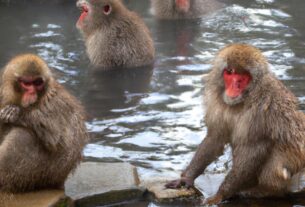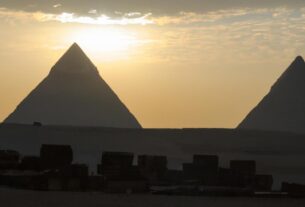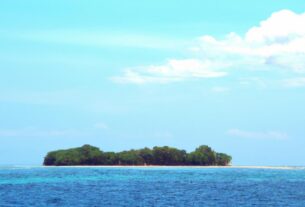Have you ever come across a lake that boasts a natural pink hue? Prepare to be captivated by the wonders of Lake Hillier in Western Australia. Situated on the edge of Middle Island, the largest island in a quaint archipelago off the coast of Western Australia, this stunning body of water is truly a sight to behold.
Lake Hillier has long been a subject of scientific research due to its extraordinary, vibrant pink color that seems straight out of a fairy tale. It’s so vivid that it resembles a magnificent pool of strawberry milkshake. But what exactly gives this lake its mesmerizing pink pigmentation?
The unique coloring of Lake Hillier can be attributed to a microorganism known as Dunaliella salina. This organism produces carotenoids, natural pigments that lend the lake its striking pink hue. The high salt concentration in the lake, along with ideal temperature and ample sunlight, creates the perfect environment for these microorganisms to thrive.
The scientific community has been ardently studying Lake Hillier for years, intrigued by its distinctive coloration and high salt concentration. Beyond its aesthetic appeal, the lake serves as a valuable resource for researchers in the fields of microbiology, marine biology, and environmental science. Additionally, it plays a vital role in the local ecosystem, contributing to the overall well-being of its surroundings.
Come along as we unravel the mysteries of Lake Hillier, exploring its geological formation, diverse biodiversity, ongoing conservation efforts, and the remarkable tourism opportunities it presents.
The Science behind the Pink Color
The Natural Phenomenon that Causes the Lake’s Pink Color
The pink coloration of Lake Hillier is a natural phenomenon that has puzzled scientists and visitors alike for years. The explanation, surprisingly simple, lies in the presence of a single-celled alga called Dunaliella salina. This alga produces a pigment that imparts the lake its distinct pink color.
The intensity of the pink hue is most pronounced during the Australian summer when the temperature rises, and the alga thrives. The angle and intensity of the sun’s rays also influence the lake’s appearance, making it appear more or less pink depending on the time of day.
The Microorganisms and Minerals That Contribute to the Coloration
Dunaliella salina isn’t the sole factor that contributes to Lake Hillier’s coloration. The lake is also rich in minerals like calcium and magnesium, which react with the salt in the water to create a unique ecosystem, facilitating the growth of the alga. The lake’s high salt concentration, comparable to that of the Dead Sea, further enhances its pink hue.
During photosynthesis, the alga produces beta-carotene, a natural pigment responsible for the lake’s pink color. The high salt concentration creates an environment where the alga can thrive, tolerating extreme conditions that other microorganisms cannot.
Comparison to Other Pink Lakes around the World
While Lake Hillier stands out as one of the world’s few pink lakes, it’s not alone. Other notable examples include Lake Retba in Senegal and Lake Masazir in Azerbaijan. However, what sets Lake Hillier apart is the striking contrast between its pink waters and the dense eucalyptus and paperbark forests that surround it. Its location on an island amplifies the allure and mystique that envelop the lake.
Geological Formation of Lake Hillier
Formation of the Lake and Surrounding Landscape
Lake Hillier finds its home on Middle Island, the largest island within the Recherche Archipelago of Western Australia. Composed primarily of granite estimated to be around 600 million years old, the island boasts a mesmerizing natural display. The lake stretches approximately 600 meters in length, spans 250 meters in width, and reaches a depth of around 10 meters.
The exact formation of Lake Hillier remains a topic of geological debate. Some theories propose that a meteorite impact created a crater that later filled with water, while the most widely accepted theory suggests that salt deposits accumulated over thousands of years, resulting in the formation of the lake.
Geological Factors Contributing to Lake Hillier’s Creation
The surrounding landscape of Lake Hillier is predominantly composed of sand dunes shaped by the area’s prevailing winds. These sand dunes are believed to have trapped rainwater, which mixed with the salt deposits, leading to the creation of a saline solution. Over time, this saline solution accumulated in a natural depression, eventually giving rise to Lake Hillier.
Historical Significance of the Area
Lake Hillier and the Recherche Archipelago bear great historical significance for Western Australia. They were initially discovered by the British navigator Matthew Flinders in 1802. Subsequently, the islands served as a base for the whaling industry in the 19th century, followed by guano mining, which involved extracting bird droppings for use as fertilizer.
Today, the area entices visitors from around the globe, drawing them in with the allure of Lake Hillier’s natural beauty and the rich history pervading the region.
Biodiversity and Conservation Efforts
Flora and Fauna
Despite its high salt concentration, Lake Hillier harbors a diverse range of plant and animal life. The surrounding area is adorned with dense shrubland and woodland, creating habitats for various bird species, including the Western Bowerbird and the Black-faced Cuckoo-Shrike. The lake itself is home to several species of algae and other microorganisms, as well as a variety of brine shrimp and small fish.
Threats and Conservation
Lake Hillier’s unique beauty is not without its ecological challenges. As tourism and human activity increase around the lake, pollution, habitat destruction, and disturbance of local wildlife have become significant concerns. Climate change poses another looming threat, as rising temperatures and shifting weather patterns could disrupt the delicate balance of the lake’s ecosystem.
To safeguard Lake Hillier and its surrounding environment, dedicated conservation efforts have been initiated. The area around the lake is now part of a protected nature reserve, subjecting tourism and development to strict regulations. Additionally, ongoing scientific research furthers our understanding of the lake’s ecosystem and aids in devising strategies for its long-term protection and preservation.
Visitors’ Role in Preservation
As a visitor to Lake Hillier, there are essential steps you can take to help preserve the delicate ecosystem. Firstly, adhering to the regulations and guidelines set by local authorities is crucial. This entails refraining from littering, respecting wildlife, and sticking to designated trails and paths.
Supporting local conservation initiatives by donating to organizations dedicated to protecting the area is another impactful way to contribute. Finally, by spreading awareness about the significance of preserving Lake Hillier and other natural wonders, you can help ensure their endurance for future generations.
Tourism and Recreation
Tourist Attractions and Activities
Lake Hillier undoubtedly ranks among Western Australia’s most breathtaking natural wonders. Each year, countless tourists from around the world flock to this unique lake to witness its awe-inspiring beauty and partake in a host of exciting activities.
Visitors can indulge in a scenic helicopter tour to capture the perfect aerial view of the pink waters or opt for a boat ride to the island, relishing a swim in the lake. The area is also popular for fishing, kayaking, and scuba diving, offering glimpses of a diverse marine life, including sea urchins, fish, and even sharks.
Local Culture and Traditions
Lake Hillier holds a significant place in the local culture and traditions of Western Australia. Located on the ancestral lands of the Indigenous people, the lake plays an essential role in their cultural heritage. By embarking on a guided tour of the lake and its surroundings, visitors can delve into the history of the area and learn about the traditions of the Indigenous people.
Advice for Visitors
While visiting Lake Hillier, it is imperative to respect the environment and the local community. Adhering to guidelines set forth by the local authorities, such as refraining from littering or damaging the natural surroundings, is of utmost importance. Furthermore, it is crucial to avoid touching or disturbing the lake’s water to preserve its delicate ecosystem.
To make the most of your Lake Hillier experience, plan your visit during the summer months when the weather is warm and sunny. Preparing a well-thought-out itinerary ensures you can maximize your time and embrace everything the lake has to offer.
Don’t miss this extraordinary opportunity to witness the natural beauty of Lake Hillier and immerse yourself in the local culture and traditions of Western Australia.
In conclusion, Lake Hillier undeniably ranks among the world’s most remarkable natural wonders. Its distinctive pink color, attributed to the presence of Dunaliella salina microorganisms, has captivated scientists and tourists alike for years.
The study of Lake Hillier offers valuable insights into microbiology, marine biology, and environmental science. Additionally, it grants us a glimpse into the geological formation of the area and its significance to the local ecosystem.
As we delve deeper into our understanding of Lake Hillier, it becomes increasingly vital to prioritize conservation efforts and safeguard this invaluable resource. Visitors to the area must remain mindful of the environment and exhibit respect for the local culture and traditions.
At TooLacks, we firmly believe that exploring the wonders of the natural world is paramount in promoting environmental awareness and conservation. Our hope is that this article has inspired you to delve further into the wonders of Lake Hillier and the countless fascinating natural marvels that grace our planet. To learn more about TooLacks, visit our website here.



